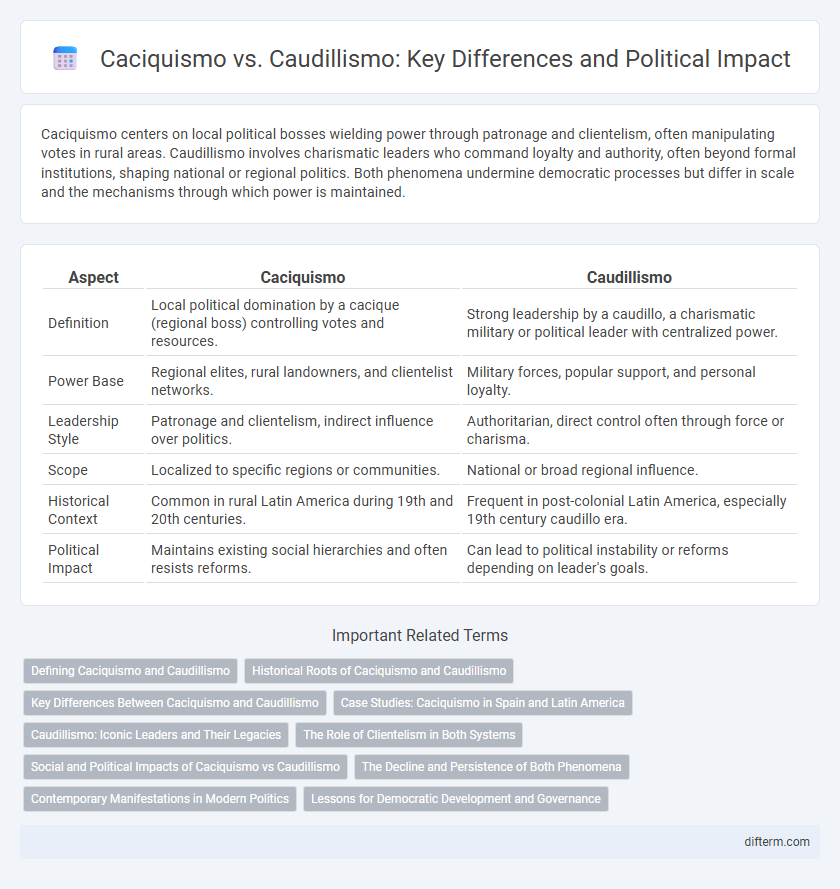Caciquismo centers on local political bosses wielding power through patronage and clientelism, often manipulating votes in rural areas. Caudillismo involves charismatic leaders who command loyalty and authority, often beyond formal institutions, shaping national or regional politics. Both phenomena undermine democratic processes but differ in scale and the mechanisms through which power is maintained.
Table of Comparison
| Aspect | Caciquismo | Caudillismo |
|---|---|---|
| Definition | Local political domination by a cacique (regional boss) controlling votes and resources. | Strong leadership by a caudillo, a charismatic military or political leader with centralized power. |
| Power Base | Regional elites, rural landowners, and clientelist networks. | Military forces, popular support, and personal loyalty. |
| Leadership Style | Patronage and clientelism, indirect influence over politics. | Authoritarian, direct control often through force or charisma. |
| Scope | Localized to specific regions or communities. | National or broad regional influence. |
| Historical Context | Common in rural Latin America during 19th and 20th centuries. | Frequent in post-colonial Latin America, especially 19th century caudillo era. |
| Political Impact | Maintains existing social hierarchies and often resists reforms. | Can lead to political instability or reforms depending on leader's goals. |
Defining Caciquismo and Caudillismo
Caciquismo refers to a political system dominated by local power brokers, or caciques, who control votes and influence through patronage and clientelism, often in rural settings. Caudillismo involves a dominant leader known as a caudillo, who centralizes authority through personal charisma, military power, and populist support, typically emerging during periods of political instability. Both concepts highlight different forms of authoritarian control, with caciquismo emphasizing localized influence and caudillismo focusing on centralized, charismatic leadership.
Historical Roots of Caciquismo and Caudillismo
Caciquismo originated in colonial Spain and Latin America as a system where local political bosses, or caciques, controlled rural areas through patronage and social hierarchy, maintaining influence over voting and resource distribution. Caudillismo emerged in the 19th century post-independence Latin America, characterized by charismatic military or political leaders, known as caudillos, who wielded centralized authority through personalist rule and populist appeal. Both phenomena reflect power structures rooted in historical social inequality and weak state institutions, shaping political landscapes with localized dominance versus centralized autocratic control.
Key Differences Between Caciquismo and Caudillismo
Caciquismo refers to a political system dominated by local bosses, or caciques, who exert control through patronage and clientelism within specific regions, while caudillismo centers around charismatic military or political leaders, known as caudillos, who hold power through personal authority and often militarized support. The key difference lies in the scale and nature of influence: caciquismo emphasizes decentralized, localized power structures dependent on networks of loyalty, whereas caudillismo involves centralized authority rooted in individual dominance and often authoritarian rule. These distinctions affect governance styles, with caciquismo sustaining oligarchic local control and caudillismo shaping national leadership often linked to populism or dictatorship.
Case Studies: Caciquismo in Spain and Latin America
Caciquismo in Spain and Latin America manifests as localized political control exerted by influential figures known as caciques, who manipulate electoral outcomes and maintain power through patronage networks. In rural Spain, especially Andalusia and Galicia, caciques dominated 19th and early 20th-century politics by controlling votes and influencing state policies to favor elite interests. Latin American cases, such as Mexico's Porfiriato and Argentina's rural provinces, reveal how caciquismo entrenched social inequalities and hindered democratic development by linking economic power with political authority.
Caudillismo: Iconic Leaders and Their Legacies
Caudillismo centers on charismatic leaders who wielded personalist power, shaping political landscapes through strong, often authoritarian rule. Iconic figures such as Juan Manuel de Rosas in Argentina and Antonio Lopez de Santa Anna in Mexico exemplify caudillismo's reliance on military prowess and populist appeal to maintain control. Their legacies remain contentious, marked by both nation-building achievements and the suppression of democratic institutions.
The Role of Clientelism in Both Systems
Caciquismo and caudillismo represent distinct political structures where clientelism plays a pivotal role in maintaining power and influence. In caciquismo, local political bosses, or caciques, establish extensive patron-client networks to secure voter loyalty and control regional resources, often blending traditional authority with formal governance. Caudillismo centers on charismatic military or political leaders who leverage personal loyalty and direct material benefits to supporters, reinforcing their dominance through personalized clientelist relationships rather than institutional frameworks.
Social and Political Impacts of Caciquismo vs Caudillismo
Caciquismo entrenches local political elites who manipulate electoral processes to maintain power, fostering social inequality and inhibiting democratic development. Caudillismo centers around charismatic, authoritarian leaders who mobilize popular support, often disrupting institutional stability but promoting rapid centralization of authority. The social impact of caciquismo includes entrenched patronage networks that limit social mobility, while caudillismo often triggers political polarization and civil unrest.
The Decline and Persistence of Both Phenomena
Caciquismo and caudillismo have experienced a decline in traditional forms due to democratization and institutional reforms in Latin America and Spain. However, both phenomena persist through informal political networks and charismatic local leaders who continue to influence elections and governance. Modern manifestations often blend clientelism and personalismo, reflecting adaptive strategies within evolving political systems.
Contemporary Manifestations in Modern Politics
Contemporary manifestations of caciquismo persist in localized political patronage systems, where influential figures control voting blocs through clientelism and resource distribution. In contrast, caudillismo is evident in charismatic leaders who centralize authority, often bypassing institutional checks to maintain personal power. Both phenomena undermine democratic processes by promoting personalized governance over institutional accountability.
Lessons for Democratic Development and Governance
Caciquismo undermines democratic development by concentrating power in local political bosses who manipulate elections and maintain clientelistic networks, limiting broad citizen participation. Caudillismo threatens governance through authoritarian leadership styles that prioritize personal loyalty over institutional accountability, weakening democratic institutions. Promoting transparent, inclusive political processes and strengthening institutional checks are essential to counter both phenomena and foster democratic resilience.
caciquismo vs caudillismo Infographic

 difterm.com
difterm.com